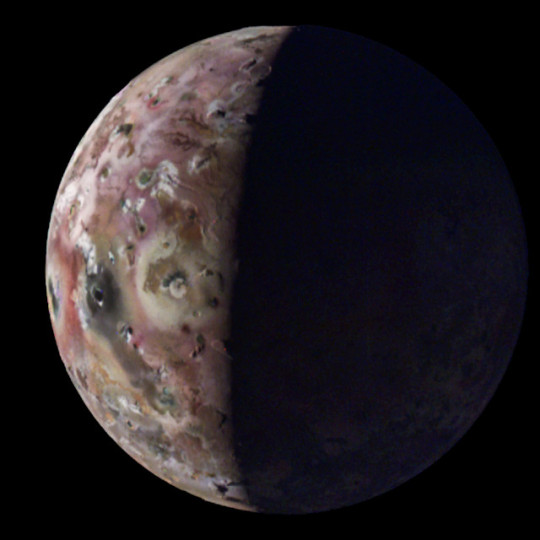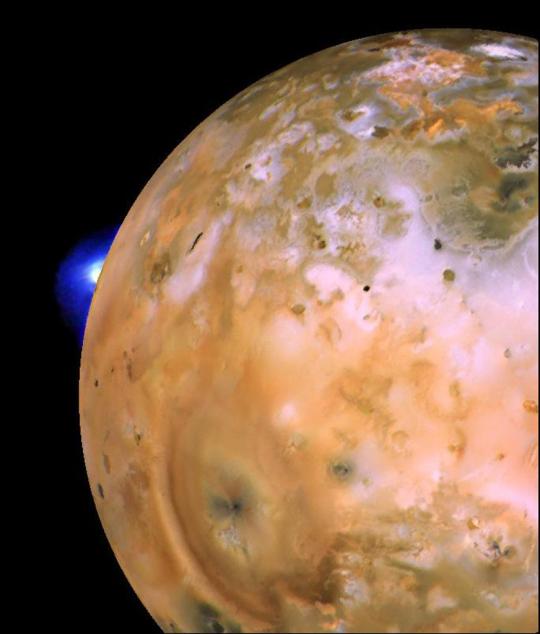#loki patera
Explore tagged Tumblr posts
Text

At the European Geophysical Union General Assembly held in Vienna last week, NASA's Juno mission principal investigator Scott Bolton illustrated some new discoveries offered by the Juno space probe, including some regarding Io, Jupiter's volcano-covered moon. Io was also studied by a team of researchers who used the ALMA radio telescope to map the movements of sulfur isotopes and reconstruct the tidal heating that generates the intense volcanic activity. The results were published in an article in the journal "Journal of Geophysical Research: Planets".
17 notes
·
View notes
Text
2 DAYS LEFT
Tournament of Lokis 2024
So far this has raised $130 (Some generous donors donated more despite not knowing more Lokis to submit).
Friendly reminder that I'm currently taking submissions for the Tournament of Lokis until Jun 30, 2024 July 15,2024.
To submit a Loki into the Tournament:
-Any Loki is allowed. e.g. Goro Akechi from Persona 5 is allowed.
-Due to recent events, I won't allow Lokis from Neil Gaiman's works anymore. Consider it a precaution.
-Send me proof through DMs or asks of a donation of $5 or more to Gaza's Water Municipality:
Or any of these:
-Every $5 is a Loki submission. If you wish to submit 2 Lokis you'll have to donate $10.
Tournament of Lokis 2024: Nominations so Far (will update w/each submission):
PLEASE REBLOG SO MORE PEOPLE CAN SEE IT AND SUBMIT SOMETHING
#tournament of lokis 2024#gow#atreus#kratos#god of war#gowr#norse mythology#loki#LokiInMedia#joanne harris#dianna wynne jones#the mechanisms#the bifrost incident#tbi#rick riordan#riordanverse#destripando la historia#dislyte#triki#assassin's creed#ac valhalla#basim ibn ishaq#louie stowell#the mask#alan cumming#son of the mask#the binding of isaac#loki patera#volcano#astronomy
13 notes
·
View notes
Text







【 now available 】
LOKI PATERA.
* ALL INTERNATIONAL ORDERS CAN BE PURCHASED VIA PAYPAL.
3 notes
·
View notes
Text

*Artist's concept of Loki Patera, a shining 'lava lake', on Jupiter's moon Io. Image from video. (Credits at end of video.) *Artist (my guess) is Björn Jónsson, who did the image processing for the original photos too, (seen & credited here apart from video):
0 notes
Text
0 notes
Text
NASA reveals Steeple Mountain and Loki Patera lava lake on Jupiter moon Io in new animation
NASA reveals Steeple Mountain and Loki Patera lava lake on Jupiter moon Io in new animation #nasa #jupiter #io #steeplemountain #lokipatera #juno
Two recent flybys of Io, Jupiter’s intriguing moon, by the NASA Juno spacecraft, have revealed more detail about the most volcanic world in the solar system. As a result, the Juno spacecraft data has been used to create an animation of “Steeple Mountain” and a lava lake known as Loki Patera on Jupiter’s moon Io. Fly over a mountain and lava lake on Jupiter’s moon Io! Animation from spacecraft…
youtube
View On WordPress
0 notes
Text
Molten Lake on Jupiter's Moon Io
youtube
This animation of Loki Patera, a lava lake on Jupiter’s moon Io, is an artist’s conception made using imagery taken by NASA’s Juno spacecraft.
With multiple islands, Loki Patera is filled with magma and molten lava.
8 notes
·
View notes
Text
We have Sapphic and Achillean... I'm proposing a new term for nonbinary romance
It's time we had a way to describe nonbinary relationships, an equivalent to Sapphic and Achillean
So I give you...
Lokian adj.
Of, pertaining to, resembling, or characteristic of Loki, the Norse trickster god (the OG genderfucker)
Being or pertaining to an intra-patera volcanic eruption, one confined inside a patera (caldera).
a. A nonbinary person attracted to other nonbinary people b. NBi/NBi romance
Thoughts? Questions? Feedback? 🤓
(Shout out to my friend Sydney who suggested Loki, you're a genius 😘)
#romance#queer#sapphic#achillean#wlw#mlm#nblnb#nonbinary#genderqueer#genderfluid#genderfuckery#loki#lokian#volcanoes are genderqueer#an all purpose versatile term if I may say so myself#we're making fetch happen
14 notes
·
View notes
Text
Juno flew within 930 miles AKA 1,500 kilometers of the volcanic surface. Scientists have been viewing Io for decades but this is the first time the moon was viewed from close up.
Lakes of Lava with islands of solid rock are shown in the pictures.
Jupiter has 3 other Galilean Moon Europa, Ganymede and Callisto.
Juno has revealed volcanoes and Loki Patera lake of lava on Io.
Juno will fly closer to the North Pole of Jupiter and observe tornadoes the size of Earth's continents. They are also looking for signs of water on Jupiter measuring Hydrogen and Oxygen gas.
#science article#outer space#jupiter#jupiter moons#nasa#lava#space photography#space probe#galilean moons
2 notes
·
View notes
Text
NASA reveals 'glass-smooth lake of cooling lava' on surface of Jupiter's moon Io
The volcanic surface of Jupiter's huge moon Io got a stunning close-up thanks to NASA's Juno mission.

A new animation reveals an enormous lava lake on the surface of Jupiter's moon Io. The close-up view comes from NASA's Juno spacecraft, which swept within 930 miles (1,500 kilometers) of the volcanic surface of Io in December 2023 and January 2024. These flybys provided the closest look ever at Jupiter's innermost large moon. Io hosts hundreds of active volcanoes. According to NASA, their eruptions are sometimes so powerful that they can be seen with telescopes on Earth.
The new images show Loki Patera, a 127-mile-long (200 km) lava lake on Io's surface. Scientists have been observing this lava lake for decades. It sits over the magma reservoirs under Io's surface. The cooling lava at the center of the lake is ringed by possibly molten magma around the edges, Scott Bolton, principal investigator for the Juno mission, said during a news conference Wednesday (April 16) at the European Geophysical Union General Assembly in Vienna.
"The specular reflection our instruments recorded of the lake suggests parts of Io's surface are as smooth as glass, reminiscent of volcanically created obsidian glass on Earth," Bolton said.
Rugged islands of rock crowd the lava lake's interior. "There is amazing detail showing these crazy islands embedded in the middle of a potentially magma lake rimmed with hot lava," Bolton said.
Juno's instruments have determined that Io's surface is smoother than the surfaces of Jupiter's three other Galilean moons (Europa, Ganymede and Callisto). Io is slightly larger than Earth's moon, and the surfaces that aren't molten are largely covered with yellow sulfur and sulfur dioxide.
Juno continues to fly over Jupiter, collecting data about its dramatic polar cyclones, each of which is the width of the continental U.S. The mission is also measuring levels of oxygen and hydrogen in Jupiter's atmosphere. The spacecraft will complete its 61st flyby of Jupiter on May 12.
3 notes
·
View notes
Text
James Webb Space Telescope Discovers Surprising Revelations about Ganymede and Io. Full article here

🔭 The James Webb Space Telescope (JWST) is on a roll, revealing jaw-dropping discoveries about Jupiter's fascinating moons, Ganymede and Io! 🔭
🌌 Ganymede - The Largest Moon's Hidden Secret 🌌 JWST's sensitive infrared cameras exposed hydrogen peroxide (H2O2) around Ganymede's poles, a first-time detection! 🌠 The moon's magnetic field directs charged particles from Jupiter's magnetosphere towards the poles, causing a captivating process called radiolysis, altering the polar caps' surface chemistry. 🌈 This exciting find sheds light on icy bodies' chemistry across the outer solar system, unlocking the secrets of neighboring moons like Europa and Callisto! 🪐
🌋 Io - Unraveling Sulfurous Volcanic Mysteries 🌋 Io's volcanic prowess comes to the fore with JWST's high-resolution spectrometer. The thermal infrared measurements captured intense eruptions at Kanehekili Fluctus and Loki Patera. 🌋🔥 Thanks to JWST's observations, scientists linked sulfur monoxide (SO) emissions to volcanic activity, deepening our knowledge of Io's extreme geology and atmosphere. 🌠🔍
🚀 Exciting Times for Astronomy! 🚀 JWST's Early Release Science program is unlocking the cosmos' hidden gems! 🌟 These discoveries highlight the importance of investing in advanced space telescopes to unravel the universe's mysteries. 🌌 Let's celebrate the triumphs of science and look forward to more groundbreaking revelations from the James Webb Space Telescope! 🎉
📷 Image Credit: Samantha Trumbo, Cornell [Ganymede], and Imke de Pater, UC Berkeley [Io]
Download James Webb Discovery app at www.jameswebbdiscovery.com

13 notes
·
View notes
Text
Juno Spots ‘Hot Rings’ on Jupiter’s Volcanic Moon Io
These bright (hot) ‘thermal rings’ are a common phenomenon, and they are indicative of active lava lakes, according to a new analysis of data from the Jovian Infrared Auroral Mapper (JIRAM) instrument on NASA’s Juno spacecraft. Visible maps, infrared radiance maps and temperature maps for Loki Patera and Dazhbog Patera. Image credit: Mura et al., doi: 10.1038/s43247-024-01486-5. Io is the…

View On WordPress
0 notes
Text
3 DAYS LEFT
Tournament of Lokis 2024
So far this has raised $130 (Some generous donors donated more despite not knowing more Lokis to submit).
Friendly reminder that I'm currently taking submissions for the Tournament of Lokis until Jun 30, 2024 July 15,2024.
To submit a Loki into the Tournament:
-Any Loki is allowed. e.g. Goro Akechi from Persona 5 is allowed.
-Due to recent events, I won't allow Lokis from Neil Gaiman's works anymore. Consider it a precaution.
-Send me proof through DMs or asks of a donation of $5 or more to Gaza's Water Municipality:
Or any of these:
-Every $5 is a Loki submission. If you wish to submit 2 Lokis you'll have to donate $10.
Tournament of Lokis 2024: Nominations so Far (will update w/each submission):
PLEASE REBLOG SO MORE PEOPLE CAN SEE IT AND SUBMIT SOMETHING
#tournament of lokis 2024#gow#atreus#kratos#god of war#gowr#norse mythology#loki#LokiInMedia#joanne harris#dianna wynne jones#the mechanisms#the bifrost incident#tbi#rick riordan#riordanverse#destripando la historia#dislyte#triki#assassin's creed#ac valhalla#basim ibn ishaq#louie stowell#the mask#alan cumming#son of the mask#the binding of isaac#loki patera#volcano#astronomy
13 notes
·
View notes
Text





【 Today’s Outfits 】
LOKI PATERA.
* ALL INTERNATIONAL ORDERS CAN BE PURCHASED VIA PAYPAL.
2 notes
·
View notes
Link
NASA's Juno spacecraft came within 1,500 km (930 miles) of the surface of Jupiter's moon Io in two recent flybys. That's close enough to reveal new details on the surface of this moon, the most volcanic object in the solar system. Not only did Juno capture volcanic activity, but scientists were also able to create a visual animation from the data that shows what Io's 200-km-long lava lake Loki Patera would look like if you could get even closer. There are islands at the center of a magma lake rimmed with hot lava. The lake's surface is smooth as glass, like obsidian.
0 notes
Photo

VOLCANISM ON IO Io, the innermost of Jupiter's four Galilean moons, was discovered by Galileo Galilei on January 8, 1610. The first reported observation of Io was actually on January 7, but at that time Galileo observed Io and Europa as a single point of light. It wasn't until the following day that he realized he had actually discovered two moons, not just one.
In addition to being the fourth largest moon in the solar system with a diameter of 3,642 kilometers, Io is also the most geologically active object in the solar system. The moon is mainly composed of silicate rock with a molten iron or iron sulphide core. There is also evidence of uplift from extensive compression. Based on observations made by the five interplanetary space probes that have passed by it since 1979, scientists believe Io may have up to 400 volcanoes on its surface, at least 150 of them documented to be currently active. Io is one of five bodies in the solar system known to be currently volcanically active. The others are the Earth, Venus, Enceladus (Saturn II), and Triton (Neptune I). Some scientists believe that Mars, Europa (Jupiter II), Titan (Saturn VI), and Dione (Saturn IV) may also be geologically active, but evidence for this is inconclusive. The first discovery of volcanic activity on Io occurred on March 8, 1979. In a procedure known as optical navigation, Voyager 1 took images of Jupiter and its moons to determine its exact location. A 300-kilometer high volcanic plume was discovered from this image of Io. Upon comparing this image with earlier images, seven other plumes were discovered. Unlike Earth and Venus, Io's volcanic activity is not a result of internal heating, but instead is from external factors (scientists aren't sure what causes cryovolcanic activity on Enceladus and Triton). Io's proximity to Jupiter results in a gravitational tug-of-war between Jupiter and Io; this causes an effect known as tidal heating. Unlike the moon's tug on Earth which changes the tide of the oceans, Jupiter's tug on Io changes the shape of the entire surface. This constant change in Io's shape causes constant volcanic activity. The colors on Io’s surface are largely due to allotropes and compounds of sulphur. Many of the volcanoes on Io produce plumes of sulphur and sulphur dioxide which can reach up to 500 km above the surface. Lava flows on Io, some more than 500 km long, are mostly basaltic with either mafic or ultramafic (magnesium-rich) compositions, a similar composition to lava flows seen on Earth at shield volcanoes like Kīlauea in Hawaii. By-products of these eruptions include sulphur, sulphur dioxide gas and silicate pyroclastic material and possible sodium, potassium, and chlorine. These materials are blown into space at speeds reaching 1km/s. Temperatures as high as 1,600K (1,300°C) have been recorded within these eruptions. At least one volcano on Io is known to have been active for at least 18 years. The volcanic activity on Io provides materials for the thin atmosphere. A recent study looked at the thermal emission from 240 active or recently active volcanic features on Io to identify the amount and area that the volcanic heat flowed during the Galileo epoch (the period during which the orbiter Galileo was observing Io). Spacecraft data and a geological map of Io (http://bit.ly/Qc9wbQ) were used to estimate thermally active areas. From the analysis, it was determined that outburst eruption phases and very small hot spots contribute around ∼4% of Io’s total thermal emission, while about 50% of Io’s volcanic heat flow comes from only 1.2% of its surface. Volcanic heat flow is not is more prevalent around the mid-latitudes, aside from the area around Loki Patera in the north; the largest volcanic depression on Io, containing an active lava lake. The global volcanic heat flow is dominated by thermal emission from paterae (volcanic depressions), especially from Loki Patera. Io’s paterae account for 80% of the global volcanic activity. The heat flow that is not associated with known sources could come from small hot spots or secondary volcanic processes involving sulphurous compounds, or both. This image was taken March 4, 1979 when Voyager 1 was about 490,000 kilometers from Io. While the color of the plume has been preserved, its brightness has been increased since it was extremely faint in the original photo. The altitude of the plume is about 161 kilometers. - R Atkinson & TEL Sources: http://www.solarviews.com/eng/iovolcano.htm https://science.nasa.gov/science-news/science-at-nasa/2007/09mar_alienvolcano http://stock-space-images.com/Alienvolcanoeschoose.html http://www.lpi.usra.edu/meetings/lpsc2012/pdf/2085.pdf Glenn J. Veeder, Ashley Gerard Davies, Dennis L. Matson, Torrence V. Johnson, David A. Williams, Jani Radebaugh. Io: Volcanic thermal sources and global heat flow. Icarus, 2012; 219 (2): 701 DOI:10.1016/j.icarus.2012.04.004 Photo credit: https://www.space.com/37860-voyager-mission-40-years-ed-stone-interview.html Geological map credit: ASU
#io#jupiter#moon#volcanic#volcanism#sulfur#cloud#loki patera#paterae#science#space#the universe#isuniverse#the real universe
36 notes
·
View notes